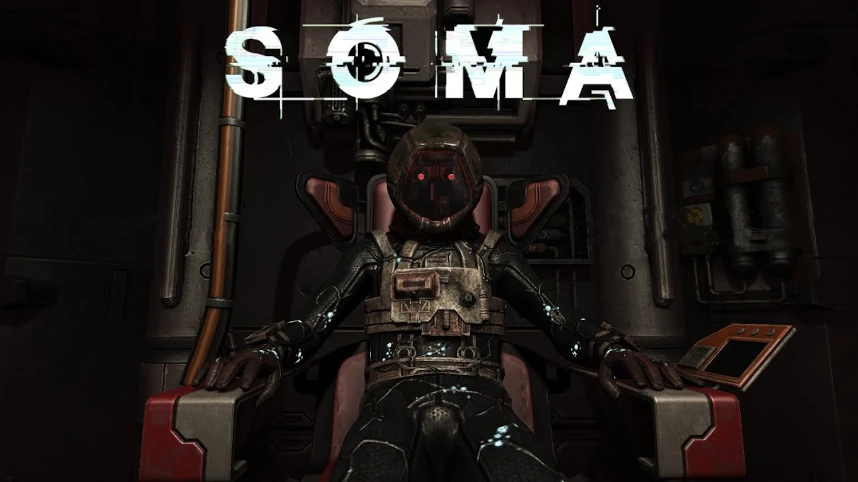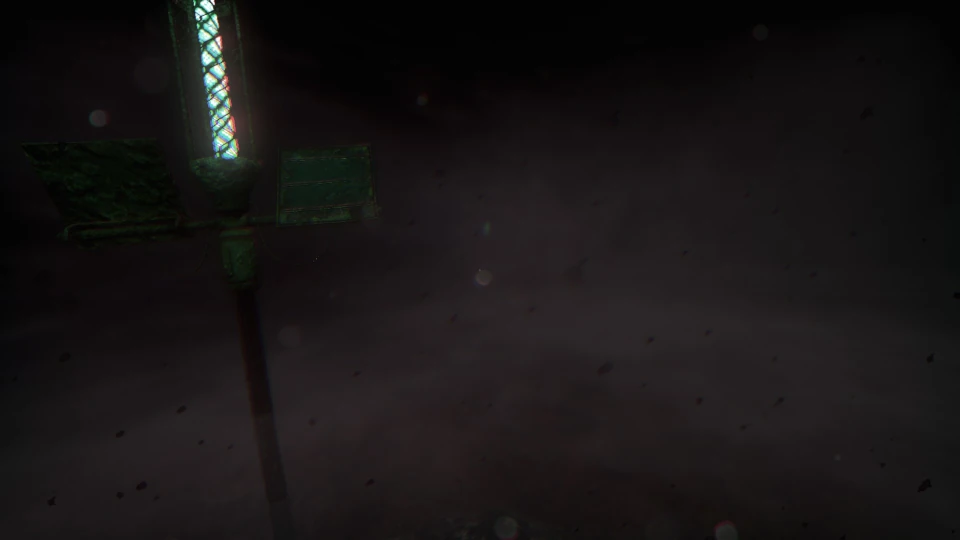Soma
by Frictional Games, published 2015

Soma is a creepy survival horror game, that leans deeply into the moral and existential quandaries arising from the deterministic principle that it's possible to scan one's brain and copy the structure into some other substrate, yielding a second conscious entity, which thinks it is you. So there are deep science-fiction issues in play here, about whether we think such a scheme could ever possibly work, and about the practical, personal, and societal ramifications of it.
Major spoilers ahead. It's seven years old at this point.
I loved the setup. A humdrum morning begins in your present-day Toronto apartment. A note on the fridge reminds you that today is the day of your medical appointment, a brain scan. Reaching the doctor's office by train, you find the experimental new type of brain scanner, run by some PhD in a cable-strewn side-office. Sit in the chair, don the helmet, wait for the scan to complete and- blink! Suddenly, you are elsewhere.
As the game progresses, it becomes obvious that the version of you that sat down in the seat did not experience this discontinuity. They completed the scan, removed the helmet, and continued their normal, everyday life.
You are not that copy. You open your eyes to a grim, decrepit cyberpunk future. Exploring, your only company is a menagerie of half-functional robots and drones, many of which are insane, and, in conversation, seem to be under the impression that they are human beings. It gradually becomes apparent that perceptual filters are in play, preventing them - and you - from noticing they are no longer human. At one point the ocean crashes in on you, and you drown for a little while, or at least think you are, but you still don't die. At that point you have to acknowledge the truth.
You have awoken to the year 2104, and the recorded brain scans of real humans are being used to animate drones. This is a scenario much like that told from a different perspective in the smashing short story Lena by qntm. Failing systems engaged fall-backs, resulting in your obsolete brain scan being yanked from storage to inhabit an advanced humanoid robot, in a facility deep under the ocean, some time after a comet strike has scoured all life from the planet's surface.
If that wasn't bad enough, one facilitating technology of this nightmarish scenario, a black goo that mimics and improves upon electrical and biological circuitry it comes into contact with, has run rampant, growing probing tendrils which are wrecking the facility. Among other effects, it has reanimated the corpses of the last few humans, who skulk around, not in a good way. As our protagonist asks, incredulously, "You mean they've been brought back to life?". Our reassuring AI companion replies "Yeah, let's call it that."
The game borrows the highly effective mechanics of Frictional's previous games, the Amnesia and Penumbra series, where the proximity of horrific, shambling enemies causes your character to experience debilitating symptoms, including, in this case, static-y visual distortions as your neural hardware suffers from some overload or interference. This applies even if you simply look at an enemy, an act which immediately draws their attention. So your only chance to survive encounters is to stay well out of sight, and actively avert your eyes so you can't even watch what's going on. Not being able to see exactly what your enemies are, or what they are up to, turns out to be fabulously scary and atmospheric. At one point it lead directly to my wife catching me staring intently at a blank, black screen for a prolonged period, with a peculiar expression on my face, as I hid in a dark cupboard waiting for the slithering sounds behind me to go away.
Spurring us through this environment are not just threats to our immediate survival, but also the adoption of a project, to launch into space a solar-powered simulation, hosting all the last remaining brain scans of the now-defunct human race, known as the 'ARK'. This will allow the on-board sims to live a prolonged period of idyllic virtual existence, preserving at least some echo of what humanity was. Since the conceit of the game is that our character is a living and conscious entity that feels real emotion, the sims on the ARK are all presumably the same, so this seems like a worthwhile endeavor.
We are guided, motivated, and assisted by "Catherine", a simulated personality running on our hand-held omni-tool, based on the brain recording of an AI researcher, whose project during her lifetime was the ARK. Plugging her in to a wall or console socket lets her interface with our surroundings, activating power supplies and manipulating machinery. She leads us through a series of undersea facilities, linked by trains, submersibles, and the occasional disorienting trudge across the murky ocean floor, stirred up by ferocious currents and landslides, populated by organic-mechanical hybrid horrors that glide by in the darkness. I found these some of the absolute best, most atmospheric "walking simulator" moments I've experienced in a game.

Is that another distant light up ahead? Good luck finding them while the currents pummel you, and hideous, deadly beasts loom out of the murk.
Along the way, we encounter a few unforgettable scenarios. We come across the failing storage system in which the last remaining copy of our own brain scan resides. I decide to flip some buttons which delete it, prompting my character to respond with something like "Let this be the last time I wake up in this godforsaken place."
At another point, we find ourselves trapped within a collapsing facility on the bottom of the ocean, with the gibbering undead hammering on the door from the next room. There is an airlock leading out into the ocean, but we would be crushed at this depth. There is no way out. Luckily, Catherine is able to guide us into assembling a more robust robot, one capable of withstanding the pressure - all we have to do is sit in the chair and activate the transfer into it. We already did this once, back in Toronto. Easy.
Except, after the transfer, we glance back across the lab at our original - the pictured chap with red LED eyes - who, we notice, is still breathing. Asking Catherine about it, she reminds us that the brain scan is not a destructive operation. He's still in there, chemically subdued for the moment, but he'll soon wake up again, wondering why the transfer didn't work. So we are left with the option of stomping out of the airlock to safety, leaving him behind to his nightmarish fate. Or flipping a switch to deactivate him before we go.
A lot of these narrative beats work better as a game than they perhaps might in a written story. They emphasize the player's complicity, your moral culpability, which is a mode that games, for all their faults, can do better than any other media. Plenty of the lesser moments along the way expose the player to decisions about unplugging some human simulation or other which declares itself to be "alive", but which is gating your progress in some way. Some of them are yourself. Some of these acts require manhandling weighty cables, which require large, insistent tugging with the mouse controls. It's not just a disembodied button press. One has to provide a determined, definitive, mechanical input to end a life. In context, the guilt feels real.
Later in the journey, we finally stumble across an honest-to-goodness real, live human being. She describes how the rest of the humans will be gathered in particular locations, while she stayed to protect the ARK. But, we tell her, we just passed through those locations, and there were no humans remaining there. We both know that the planet's surface is sterile. A beat passes before she announces "So I'm the last human being left alive." She's deathly sick, and without hope. By the end of your interactions she asks you to turn off her life-support before you leave, and stay with her for her last wheezing moments. So this is how humanity ends.
Carrying on, because what else is there to do? We finally we get the ARK loaded into the launch system that delivers it to orbit, upload our brain scans onto it just before it launches, and - we've done it! Success!
There was a moment, about five minutes before the end, when I realized what was going to happen here, even though my character had not. It was a real emotional blow. I envied and pitied him for his naive hope. For believing there was still a way out. For, of course, the ARK's launch changed nothing for us. Our simulations are aboard it, but we are still sitting here, in a broken robot corpse in a collapsing facility at the bottom of a haunted ocean on a dead planet. The dispatched copy will enjoy life on the ARK, but we - like the copy of ourselves we left behind earlier - are stuck here for good. Roll credits.